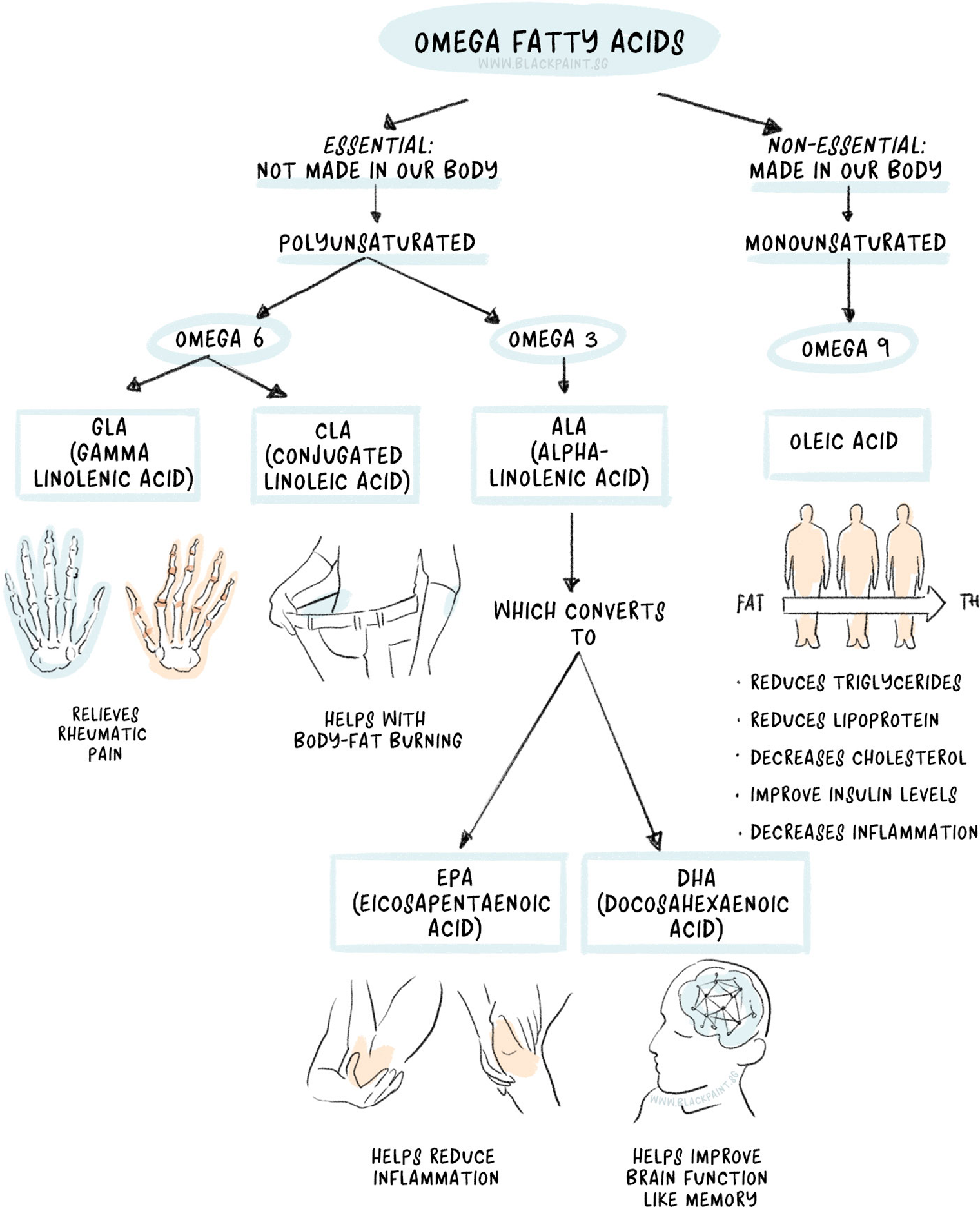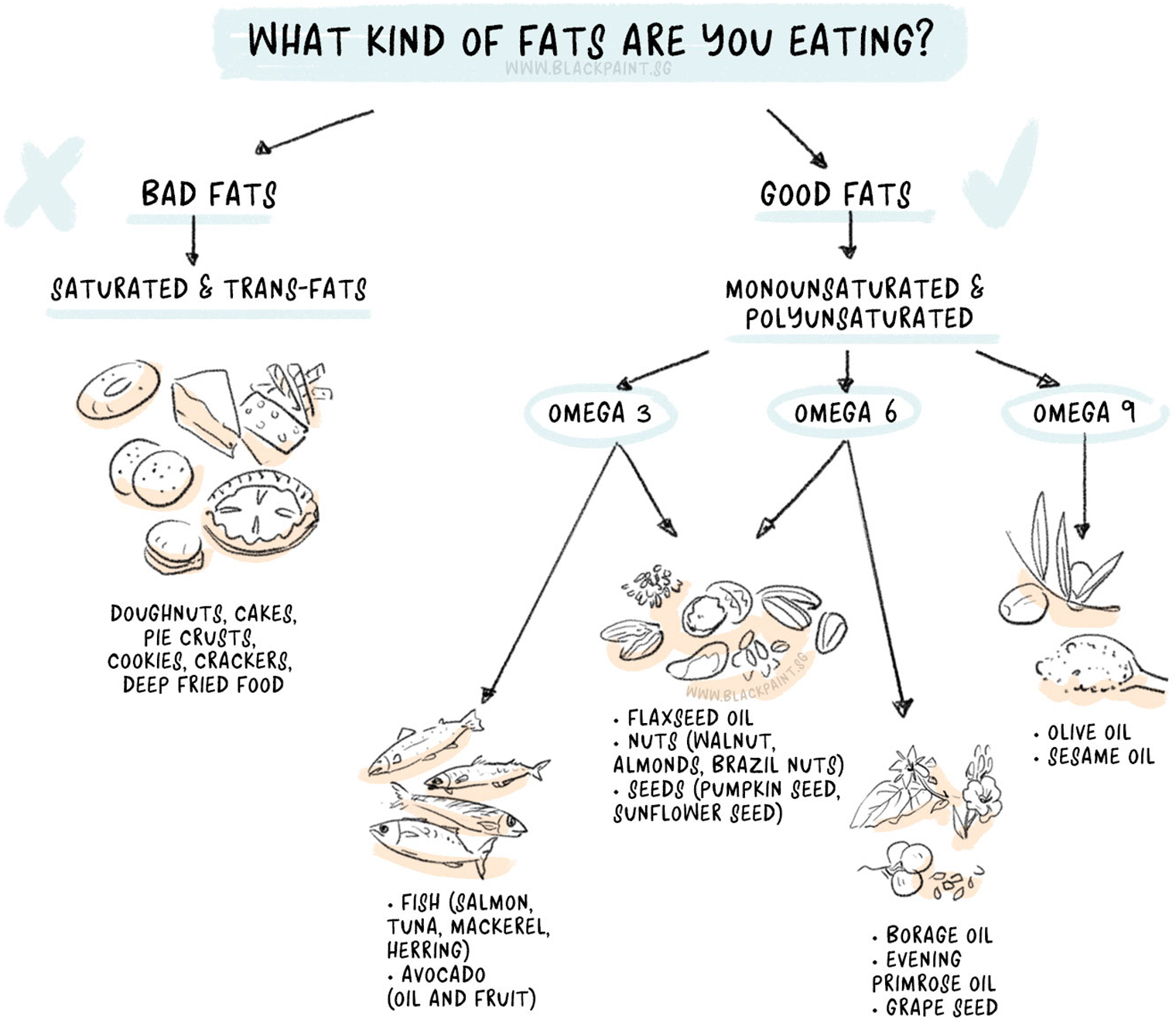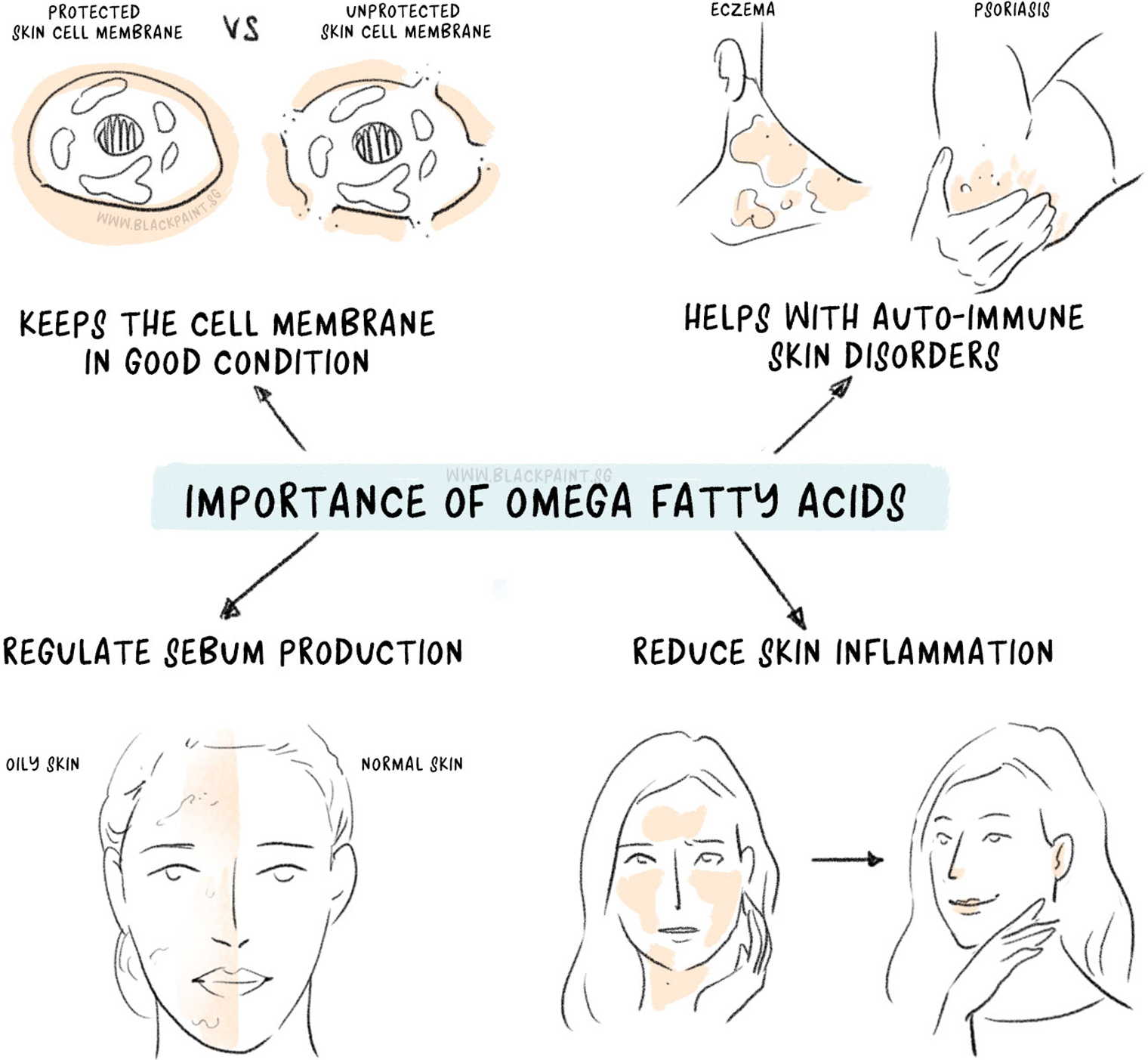In this article, we would like to tell you about healthy eating, and specifically about the omega fatty acids. Many people have heard of them, but they do not know what they are, how to get them in their diets, or how much of them we need.
Obtaining adequate amounts of omegas 3-6-9 in the diet is critical, enabling your body to function at the highest levels possible. Because we believe the omega fatty acids are so vital to the human body, we wish to pass on to you more in-depth information on these essential nutrients.
What are omega fatty acids?
There are three different types of omega fatty acids, omega-3, omega-6, and omega-9. They are found in oily foods, so do not think that cutting all fats out of your diet is a good thing. It is not. You just need to learn to avoid the “bad” fats and learn which foods contain the “good” fats that contain the omegas. Let’s have a look at the three different omegas and what they do for the body.
Omega 3 fatty acids
- EPA (eicosapentaenoic acid) is necessary for reducing inflammation in the body. EPA has been proven to reduce signs and symptoms of depression.
- DHA (docosahexaenoic acid) is essential for developing healthy brain tissue and is vital to the brain’s functioning.
- ALA (alpha-linolenic acid) converts to EPA and DHA. The body utilizes ALA for energy.
Omega 6 fatty acids:
- GLA (gamma linolenic acid) has been proven to reduce the symptoms of rheumatoid arthritis.
- CLA (conjugated linoleic acid) helps decrease your body fat mass and add energy.
Omega 9 fatty acids:
This fatty acid is a monounsaturated fat. In other words, its chemical composition differs from that of omega 3 and omega 6.
One common omega 9 fat whose name you may recognize is oleic acid. Your body can manufacture it, so this fat is considered non-essential in the diet.
This fatty acid is one of the most abundant of lipids in your body, with the following benefits:
- Reduces triglycerides
- Reduces lipoprotein
- Decreases your cholesterol numbers
- Seems to improve insulin sensitivity; as well as
- Decreases inflammation within the body
Moreover, if the proper amounts of omegas 3-6-9 aren’t balanced in the body, deficiencies result, causing a host of health issues in the liver and kidneys, poor childhood growth, decreased immunity, dry skin, depression, plaque build-up in your arteries, ulcerative colitis, joint pain, menstrual pain, and cancer.

Do I need to take omega fatty acid supplements?
There are many reasons that you can consider whether to supplement with omega fatty acids, especially if you aren’t getting enough omega fatty acids through your diet. If you want to take a supplement, it is recommended that you do not buy a combination of the omega 3-6-9 fatty acids. Instead, take an omega 3 supplement separately to omega 6 & 9.
Research has shown that there is no more benefit to taking all three fatty acids in a supplement versus just this one. Although it seems to make sense that getting a variety of healthful and essential fats in one supplement is better than a supplement that is limited to just one type of fat, it is better to stick with just an omega-3 supplement.
Knowing when to take them
The reason isn’t a problem with 3-6-9 supplements themselves, but rather with the way most of us eat. Most of us have diets that already contain way too much omega-6. As a rule, read the supplement labels carefully and be sure to pick one that says, “cold pressed,” and that also contains antioxidants like vitamin E.
In general, the two most valuable types of omega-3’s are EPA and DHA, and the dose to look at is a 3:2 ratio of the EPA to DHA amount. Because this ratio amount is the standard, actual amounts required depends on your personal needs.
- Example – 180mg EPA : 120mg DHA.
There’s actually no official recommended daily allowance, but most research recommends this minimum dose. Especially for those in doubt, check with your health practitioner. Also, check that the manufacturer used fish oil or algal oils rather than flaxseed oil.
How will I know if I have a deficiency in omega fatty acids?
Studies have found that many people are deficient in mainly omega-3’s. Most of us get enough omega-6’s in our diet, and our bodies can make omega-9’s, so 3’s are the ones to watch. Here are some of the signs to look out for. If you have any of these, look for a good omega-3 supplement or increase your dietary sources of them.
- Dry skin: Omega-3 oils keep your skin youthful and moistened, so a shortage will quickly show in your skin.
- Dull lifeless hair: Omega-3’s are also great for keeping your hair shiny and nourished from the roots. They keep scalp inflammation at bay, preventing hair loss.
- Brittle nails: If your nails are soft, peel easily or are brittle, this could be a sign of an omega-3 deficiency.
- Difficulty sleeping and fatigue: Omega-3 deficiency can lead to insomnia or concentration difficulties. According to the University of Maryland Medical Center, fatigue is a well-known sign of an omega-3 deficiency.
- Joint pain: Omega-3’s are anti-inflammatory. That’s why those with arthritis benefit from supplements of them. Joint pain could be a sign that you are lacking them.
What are the dietary sources of omega fatty acids?
Most of us who want to eat healthily today shy away from fats in our diets. The word “fat” puts a fear of consuming them into the minds of many people because people think that eating fats will make them fat. It is important to know that there are “good fats” and “bad fats”, and you need to know the difference for your health’s sake.
- “Bad fats” typically include saturated and trans fats. Avoid these at all costs. They are found in fried foods like doughnuts, and baked items such as cakes, pie crusts, cookies, crackers, and hard margarine.
- “Good fats” contain polyunsaturated fats, your omega 3-6-9 fatty acids.
Foods that contain beneficial fats:
- Fish – Cold water fish, including salmon, tuna, mackerel, halibut, sardines, herring, shrimp, red snapper, and scallops are excellent sources of omega-3’s. These wonder foods can lower high cholesterol levels to a more normal range.
- Nuts – Available all year round, nuts contain plenty of omegas. These foods also supply fiber and protein. Nuts such as cashews, almonds, pecans, walnuts, macadamia, pistachios, hazelnuts, peanuts, and Brazil nuts are great sources of the omega fatty acids.
- Seeds – Seeds are rich in omegas. Seeds, like nuts, also offer you an abundance of protein and fiber. Some examples are pumpkin seeds, sunflower, flax, pine, and sesame seeds. However, seeds do not contain any omega nine fatty acids.
- Avocados and Olives – Develop a taste for avocados because these are an excellent source of omega-3 fatty acids. Both avocados and olives contain monounsaturated fats, which reduce your risk of a stroke and heart-related diseases. Additionally, avocados and olives provide good amounts of fiber and natural potassium.
- Oils – There are so many different types of oil on the market today that buying the right oil can become confusing because different oils contain different kinds of fats. It is no wonder that the Western diet contains so many omega 6 fatty acids as our foods include many oils. All types of oil contain omega 3 or 6 or 9 fatty acids. No oil on the market includes all three fatty acids together.

To break this down further,
- Flaxseed oil offers you omega-3 and 6 fatty acids.
- Canola oil offers you omega-3 fatty acids.
- Oils like hemp seed, borage, evening primrose, soybean, safflower oil, cottonseed oil and grape seed provide omega-6 fatty acids.
- Olive oil and sesame oil contain omega 9 fatty acids.
How omega fatty acids give you healthy skin
Many of us spend a great deal of money on skin creams and cosmetics. In fact, what we eat and drink is just as important for our skin’s health. Our food is where our skin cells get the nutrients, moisture and oils they need to renew themselves and to stay healthy.
Omega-3’s are some of the most important nutrients for skin health, keeping it in good shape and maintaining immunity to external aggravators. Here are some of omega-3’s benefits to our skin:
Keeps the cell membrane in good condition
Our cell membrane is a barrier that keeps harmful substances out and allows nutrients through. If the cell membrane is healthy, it can retain moisture well, and as a result, our skin has a dewy, glowing appearance.
Reduce skin inflammation
Beyond the cell membrane, omega-3 fatty acids reduce the number of inflammatory agents that the body produces. In particular, it’s these agents that cause aging and other problems. Omega-3’s don’t only work on the cell membrane, but also on the phospholipid bilayer of the skin, helping it to retain moisture. Consequently, this brings about moist skin with plumper skin cells.
According to studies done in 2005, EDA also blocks the release of enzymes caused by damage from the sun. This protects against wrinkles.
Regulate sebum production
Omega-3’s can also help with reducing acne by regulating skin sebum production! Don’t worry that because omega-3’s are oils they will make your skin oily. They won’t because they normalize oil production, so whether your skin is dry or greasy, it will benefit from omegas.
Helps with auto-immune skin disorders
- Rosacea is the redness of the face, although sometimes this involves broken blood vessels. Because rosacea is an inflammatory process, omega 3’s anti-inflammatory properties are beneficial.
- Eczema is a very difficult skin condition to treat, as the skin is itchy, extremely dry, and cracked. Omega-3’s have been shown to ease eczema symptoms because they get to the root of the problem, which is inflammation. They also strengthen the cell membrane, which, as we’ve seen before, keeps the skin moist and dewy.
- Psoriasis is a skin condition that’s similar to eczema, with the same intense itching, flaking and dryness. Again, omega-3’s can bring relief because psoriasis is also an inflammatory condition that could be caused by an omega 3:6 imbalance.
As you can see, omega-3’s are essential for the health of your skin, so make sure you are getting enough of the foods that contain them.

What to cook to have omega fatty acids in my diet?
Well, now that you know how much you need omega 3’s in your diet, we’d like to give you a couple of healthy recipes to help you with that. Not to mention, one of them is a bonus as it needs no cooking. It’s perfect for those hot summer days when you don’t feel like going anywhere near the stove. Additionally, we included one that is a simple crumbed chicken that can be served as part of a hot or cold meal.
Refreshing tuna and avocado salad
Not only is this salad packed with omega 3’s from the avocados, olive oil, and tuna, it’s quick to make and delicious too!
1 shredded Cos lettuce
2 cans tuna chunks in olive oil, drained
½ English cucumber, sliced
2 ripe avocados, diced
1 small red onion, finely sliced
2 tablespoons balsamic vinegar
2 tablespoons extra virgin olive oil
1 teaspoon runny honey
Salt and black pepper
- Use a serving platter to assemble your salad.
- First, spread the shredded lettuce over the platter.
- Layer the tuna, cucumber, avocado and onion over the top.
- In a small cup, mix the vinegar, olive oil, honey and salt and pepper to make a dressing.
- Then, pour over the salad just before serving.
- Serve with slices of seed bread for an extra dose of omegas!
Walnut crusted chicken breasts
Simple to make and packed full of omegas from the walnuts, this chicken can be served with roasted vegetables or a green salad.
4 boneless chicken breasts, flattened slightly with a meat mallet
1 cup buttermilk
Salt
¾ cup walnuts
3 slices seed bread, stale if possible, crusts removed
1 teaspoon freshly ground black pepper
¼ teaspoon cayenne pepper
- First, put the chicken into a shallow glass dish. Sprinkle with a little salt and pour the buttermilk over. Cover and marinate in the fridge for a few hours.
- When you’re ready to cook, preheat the oven to 200°C. Line a baking sheet with non-stick baking paper.
- Then, put walnuts, bread, pepper, cayenne pepper and a pinch of salt into the food processor.
- Pulse until you have crumbs.
- Drain the excess buttermilk from the chicken and dip each piece into the crumb mixture. Afterwards, lay them on the baking sheet.
- Bake for 30-40 minutes until the chicken is done.
- Finally, serve them hot!
In conclusion
Hopefully, this article has enlightened you about just how important the omega fatty acids are. Our bodies need all of them and following a healthy diet will more than likely provide everything you need without the need to supplement.
Notably, the Mediterranean diet has been shown to be one of the healthiest ways to eat, with its abundance of vegetables, fruit, and fish, and its use of olive oil. It provides an abundance of omegas, as well as all the other vital nutrients to keep you healthy.
References
https://www.medicalnewstoday.com/articles/40253.php
https://www.healthline.com/nutrition/17-health-benefits-of-omega-3
https://www.thoughtco.com/cerebral-cortex-lobes-anatomy-373197
https://www.healthline.com/human-body-maps/retina
https://www.betterhealth.vic.gov.au/health/conditionsandtreatments/retinal-detachment
http://www.health.gov.au/internet/main/publishing.nsf/Content/chronic-cardio
http://www.myheart.org.sg/article/about-the-heart-and-heart-disease/statistics/singapore/75/
https://www.ncbi.nlm.nih.gov/pubmed/23112118
https://doi.org/10.1212/WNL.0b013e3182a9584c
http://n.neurology.org/content/81/17/1484
https://doi.org/10.3945/ajcn.110.000323
http://www.urbanchildinstitute.org/why-0-3/baby-and-brain
http://www.todaysdietitian.com/newarchives/092208p66.shtml#
https://www.cnpp.usda.gov/sites/default/files/nutrition_insights_uploads/Insight46.pdf
http://iovs.arvojournals.org/article.aspx?articleid=2188773%20#90741315
https://www.eurekalert.org/pub_releases/2011-04/foas-soc040711.php
https://www.singhealth.com.sg/PatientCare/ConditionsAndTreatments/Pages/Depression.aspx
https://www.ncbi.nlm.nih.gov/pubmed/24805797
http://doi.org/10.1155/2014/313570
https://www.ncbi.nlm.nih.gov/pmc/articles/PMC3976923/
https://www.ncbi.nlm.nih.gov/pmc/articles/PMC5481805/
https://www.ncbi.nlm.nih.gov/pmc/articles/PMC5669464/
https://www.ncbi.nlm.nih.gov/pubmed/22786509
https://www.healthline.com/health/skin-disorders/eczema-diet
https://doi.org/10.1161/CIRCULATIONAHA.108.191627
http://circ.ahajournals.org/content/119/6/902
https://www.nhlbi.nih.gov/health-topics/atherosclerosis
https://www.ncbi.nlm.nih.gov/pubmed/9497173
https://healthyforgood.heart.org/Eat-smart/Articles/Monounsaturated-Fats
https://www.hsph.harvard.edu/nutritionsource/what-should-you-eat/fats-and-cholesterol/types-of-fat/omega-3-fats/
https://ods.od.nih.gov/factsheets/Omega3FattyAcids-HealthProfessional/
https://www.globalhealingcenter.com/natural-health/benefits-of-omega-3-6-9-fatty-acids/
https://www.health.harvard.edu/mind-and-mood/12-ways-to-keep-your-brain-young.
https://www.webmd.com/beauty/features/want-healthy-skin-feed-well#1
https://skinnyms.com/walnut-crusted-chicken-breasts/
https://natashaskitchen.com/avocado-tuna-salad-recipe/








